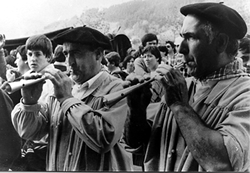Double reed instruments in the traditional culture of Euskal Herria
- Iñaki ZORRILLA
- 15/ 10/ 2001
Much has been written on the universal and the indigenous, together with what is purely traditional and what is not. What seems clear is that they lap over and that administrative borders do not exist, when we are talking about traditional culture.
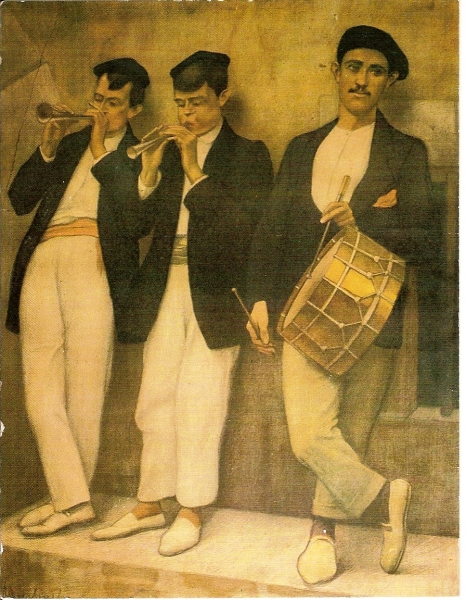
1. INTRODUCTION
2. THE INSTRUMENTS
2.1 The Sunprinu
2.2 The Navarre Pipes - The Dulzaina
2.3 The Txanbela (oboe)
1. INTRODUCTION
On the other hand, we are looking at elements that shape the music, the melody, the rhythm, the harmony and the tone, which are what determine the aesthetics of the music.
Where do we therefore draw the line between universal and indigenous?
It will be the very function of the music which determines the culturally traditional and it will also be this function which determines how a specific instrument is traditionally used.
In other words, tradition has generally been passed down orally from generation to generation. Each generation has added its grain of sand and a pure version cannot thus be defined. Therefore, music and traditional instruments have evolved and continue to evolve.
As far as the classification of the instruments is concerned, Hornbostel and Sachs developed a system based on acoustic principles, that is generally accepted. They classify the instruments in the following way:
- Idiophones
- Membranephones
- Cordophones
- Aerophones
- Electrophones
The field that we are going to consider is the aerophones, also known as wind instruments. These instruments can be divided into four types, which are pipes, reed instruments, those using lip vibration and free aerophones.
Within the reed instruments, we find the single reed instruments, such as the clarinet, and double reed instruments, also known as the oboe family.
This is the point that we wished to reach, as the instruments that we wish to discuss can be classified as narrow pipe and double reed instruments, that is to say, the oboe family.
2. The Instruments
2.1 The Sunprinu
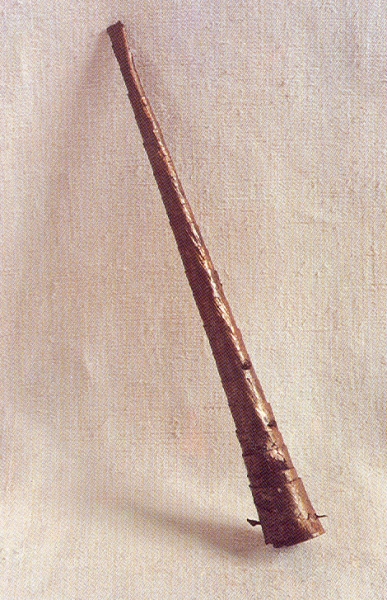
In Spring, when the trees are full of sap, the bark from a hazelnut tree is cut in a spiral shape, in such a way that this bark is used to make a conical tube, a type of cone, and a small branch is placed in its widest part to hold it together. The narrowest part is flattened to make the mouth piece. Two holes are made in the widest part, which allow the players to produce different musical notes.
The player blows through the narrowest part and covers or opens the two holes to produce different melodies, even though they only use three notes. It has practically fallen into disuse.
2.2 The Navarre Pipes - The Dulzaina
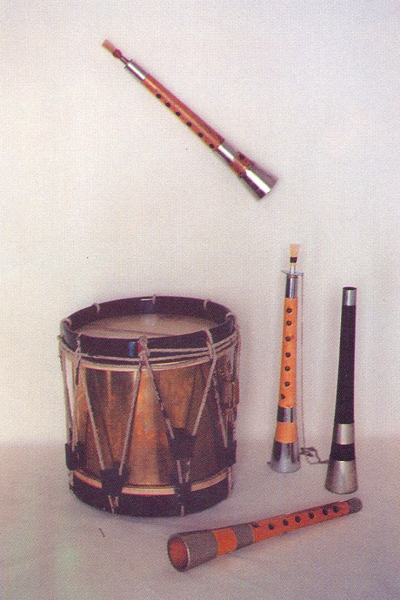
Conical wind instrument, with narrow pipes and double reed. It is between 25 and 30 centimetres long and is made up of the body and mouthpiece.
It is normally made out of wood, but some have made out of metal since the end of the last century.
The body. Narrow in the upper part, where the mouthpiece is fitted, and wide at the other end and ends in a bell-bottomed shape. According to the type of instrument, there are 7 or 8 holes to produce the different sounds. One of the holes is in the back and is played using the thumb.
The mouthpiece. It is made up of the tudel and reed. The tudel, made out of metal, acts as the joint between the reed, which is what produces the sound, and the body of the instrument, which is used to modulate the sound to produce the notes. The reed, also known as pita or pipe, is made up of two reeds, which when blown, vibrate and send the air at a certain pressure through the tudel to the body, so different sounds can be played.
The dulzaina or Navarre pipes, made out of wood, has been generally played in Navarra and Alava. In Alava, it is used to play popular music and dances, whereas in Navarra, it has an additional function and is used to play religious music, such as cathedral music. The instrument is also used in rituals and celebrations.
On the other hand, there is the case of Bizkaia and Gipuzkoa, where the instrument used was made out of metal, normally out of tin and only with seven holes. The music played with this instrument has been popular music, above all dances.
As far as the musicians are concerned, in the case of Navarra and Alava, they are normally people who have been studied music, while they normally play by ear in the Bizkaia and Gipuzkoa.
Another important difference is that this instrument is used in town in Alava and Navarra, while it is used in the country in Bizkaia and Gipuzkoa.
In Navarra and Alava, two dulzaineros are accompanied by a drum, while in Bizkaia and Gipuzkoa, one dulzainero are normally accompanied by a drum, even though it is not unusual to see two dulzaineros playing a duo and accompanied by a drum.
The urban nature of the instrument in Navarra and Alava has meant that it has been easier for the instrument to survive, while in Bizkaia and Gipuzkoa, it has been replaced by the diatonic accordion, which needs less physical effort to be played, and a process has had to be implement to prevent the instrument from disappearing.
2.3 The Txanbela
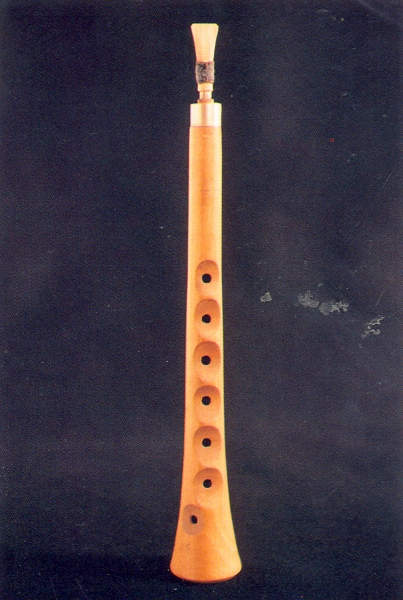
Instrument from the same family as the pipes-dulzaina, although much smaller, boxwood body, mouthpieces made out of horn or reed and has eight holes, like the wood dulzaina.
Its main feature is that it has maintained the old Basque music, used for playing modal and non-tonal music. Pierre Caubet, from Zuberoa, told us about this use of the instrument.
